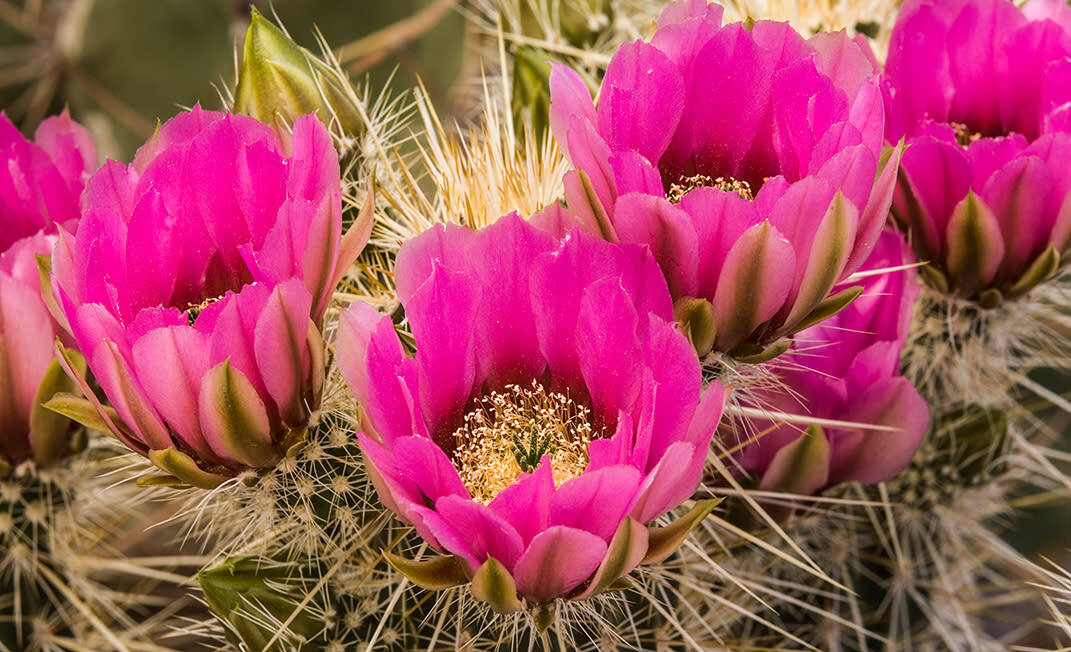The hedgehog cactus, with its compact, spherical form and dense covering of spines, is a master of survival in the harsh desert environment. Its adaptations for water conservation, heat tolerance, and natural defense offer valuable insights for creating efficient and resilient desert homes.
1. Compact Form and Efficient Space Utilization:
- The hedgehog cactus's compact, spherical form minimizes surface area, conserving water and maximizing heat tolerance.
- Architectural Application:
- We can design homes with compact, efficient layouts that minimize energy consumption and maximize usable space.
- Incorporate rounded or curved forms into the building's design, reducing solar exposure and enhancing natural ventilation.
- Design courtyards and patios with compact, intimate spaces that provide shade and privacy.
- Example:
- A home could feature a compact, circular layout with a central courtyard. Rounded or curved walls could minimize solar exposure. Intimate patio spaces could provide shaded retreats.
2. Dense Spines and Natural Defense:
- The hedgehog cactus's dense covering of sharp spines provides a formidable defense against herbivores and harsh weather conditions.
- Architectural Application:
- We can design homes with defensive features that mimic the hedgehog cactus's spines. Perforated metal screens with a dense, intricate pattern can provide shade and security.
- Incorporate layered landscaping with thorny xeriscape plants, creating a natural defensive barrier around the perimeter of the home.
- Use textured exterior surfaces, similar to the high density of small spines, to increase surface area for heat dispersion and create a visually striking façade.
- Example:
- A home could feature perforated metal screens with a dense, intricate pattern, resembling the hedgehog cactus's spines, that provide shade and security. Layered landscaping with thorny cholla and ocotillo plants could create a natural defensive barrier. Textured exterior walls could enhance heat dispersion.
3. Water Conservation and Efficient Drainage:
- The hedgehog cactus's thick, fleshy stems store water, while its spines minimize water loss.
- Architectural Application:
- We can design homes with integrated rainwater harvesting systems, channeling water into cisterns or underground storage.
- Incorporate permeable paving and drainage systems to manage stormwater runoff.
- Design landscapes with swales and rain gardens to capture and filter rainwater.
- Example:
- A home could feature a rainwater harvesting system that channels runoff from the roof into underground cisterns. Permeable paving and rain gardens could be used to manage stormwater runoff and replenish groundwater.
4. Heat Tolerance and Reflective Surfaces:
- The hedgehog cactus's light-colored spines and stems reflect sunlight, minimizing heat absorption.
- Architectural Application:
- We can choose light-colored exterior finishes, such as white or pale stucco, to reflect solar radiation.
- Incorporate reflective roofing materials and shading systems to minimize heat gain.
- Design courtyards and shaded patios to create cool microclimates.
- Example:
- A home with white stucco walls and a reflective metal roof would minimize heat absorption. Shaded patios and courtyards would provide cool outdoor spaces.
5. Resilience and Adaptability:
- The hedgehog cactus's ability to thrive in harsh conditions makes it a resilient and adaptable species.
- Architectural Application:
- We can design homes with flexible and adaptable spaces that can be easily modified to meet changing needs.
- Use locally sourced and durable materials that are well-suited to the desert environment.
- Design for passive heating and cooling, to minimize reliance on mechanical systems.
- Example:
- A home could feature modular interior walls that can be easily reconfigured. The home could be constructed from locally sourced rammed earth, providing thermal mass and durability. Passive solar design strategies could minimize the need for air conditioning.
Conclusion:
By studying the hedgehog cactus, we can design desert homes that are not only comfortable but also efficient, resilient, and adaptable. Its adaptations for compact form, natural defense, water conservation, heat tolerance, and adaptability offer valuable lessons for creating dwellings that thrive in the arid landscape. By embracing biomimicry, we can build homes that are both functional and beautiful, reflecting the wisdom of the desert ecosystem and creating harmonious living spaces.




Leave a Comment